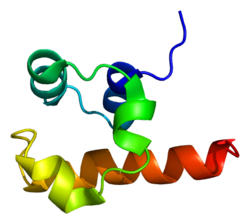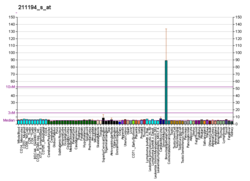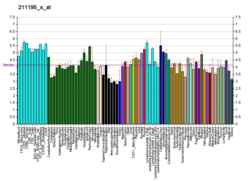| TP63 |
|---|
 |
| 사용 가능한 구조 |
|---|
| PDB | 동원체 검색: PDBe RCSB |
|---|
| PDB ID 코드 목록 |
|---|
4A9Z, 1RG6, 2RMN, 2Y9T, 2Y9U, 3QYM, 3QYN, 3US0, 3US1, 3US2, 3ZY0, 3ZY1 |
|
|
| 식별자 |
|---|
| 다른 이름 | TP63, AIS, B(p51A), B(p51B), EEC3, KET, LMS, NBP, OFC8, RHS, SHFM4, TP53CP, TP53L, TP73L, p40, p51, p53CP, p63, p73H, p73L, tumor protein p63 |
|---|
| 외부 ID | OMIM: 603273 MGI: 1330810 HomoloGene: 31189 GeneCards: TP63 |
|---|
|
| 유전자 위치 (쥐) |
|---|
 | | 염색체 | 16번 염색체 (쥐)[2] |
|---|
| | 자리 | 16 B1|16 17.37 cM | 시작 | 25,502,513 bp[2] |
|---|
| 끝 | 25,710,852 bp[2] |
|---|
|
| RNA 발현 패턴 |
|---|
| Bgee | | 인간 | 쥐(동원체) |
|---|
| 최상위 발현 | - skin of thigh
- skin of hip
- skin of arm
- 음경
- 모낭
- 음문
- 잇몸
- 유두
- 배의 피부
- gingival epithelium
|
| | 최상위 발현 | - 모낭
- 대구치
- skin of external ear
- conjunctival fornix
- skin of back
- transitional epithelium of urinary bladder
- corneal stroma
- 입술
- 혀의 윗면
- genital tubercle
|
| | 추가 참조 발현 데이터 |
|
|---|
| BioGPS | |
|---|
|
|
| 동원체 |
|---|
| 종 | 인간 | 쥐 |
|---|
| 앙트레 | | |
|---|
| 앙상블 | | |
|---|
| 유니프롯 | | |
|---|
| RefSeq (mRNA) | NM_001114978
NM_001114979
NM_001114980
NM_001114981
NM_001114982
|
|---|
NM_003722
NM_001329144
NM_001329145
NM_001329146
NM_001329148
NM_001329149
NM_001329150
NM_001329964 |
| NM_001127259
NM_001127260
NM_001127261
NM_001127262
NM_001127263
|
|---|
NM_001127264
NM_001127265
NM_011641 |
|
|---|
| RefSeq(단백질) | NP_001108450
NP_001108451
NP_001108452
NP_001108453
NP_001108454
|
|---|
NP_001316073
NP_001316074
NP_001316075
NP_001316077
NP_001316078
NP_001316079
NP_001316893
NP_003713 |
| NP_001120731
NP_001120732
NP_001120733
NP_001120734
NP_001120735
|
|---|
NP_001120736
NP_001120737
NP_035771 |
|
|---|
| 위치(UCSC) | Chr 3: 189.63 – 189.9 Mb | Chr 16: 25.5 – 25.71 Mb |
|---|
| PubMed 검색 | [3] | [4] |
|---|
|
| 위키데이터 |
|












